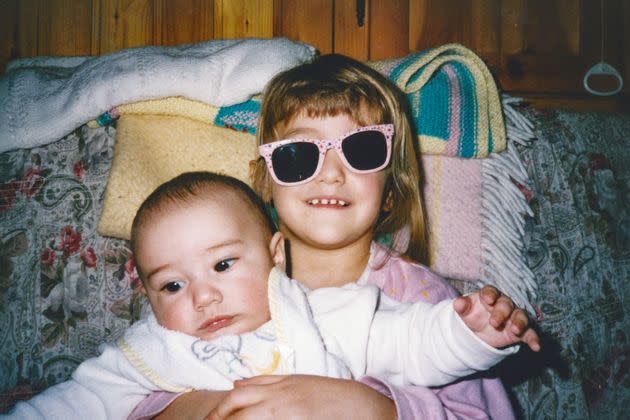
Growing up as the oldest sibling, author Y.L. Wolfe often felt the lines between her role and her mother’s role were blurred.
“By the time my youngest brother was born when I was almost 11, I was overwhelmed with feelings of responsibility for his welfare. I used to sit by his crib and watch him sleep just to make sure he was safe,” Wolfe, the oldest of four, told HuffPost.
“It wasn’t that I thought my mother wasn’t competent ― but more that I felt we were both responsible for the family by that point in my life,” she explained. “As if I was literally ‘other mom,’ rather than big sister.”
In other words, Wolfe is deeply familiar with “eldest daughter syndrome.” The internet is rife with thinkpieces about the plight of oldest daughters and tweets about how we ― I might as well reveal my bias here ― need to unionize: “If you are the oldest sibling and also a girl you may be entitled to financial compensation,” one woman joked on X, the platform formerly known as Twitter.
Though “eldest daughter syndrome” is a pop psychology term ― you won’t find it listed as an official diagnosis in the DSM-V ― a new study suggests that there may be more science to the pseudo-syndrome than previously thought.
A University of California, Los Angeles-led research team found that, in certain instances, first-born daughters tend to mature earlier, enabling them to help their mother rear younger siblings.
Specifically, the researchers found a correlation between early signs of adrenal puberty in first-born daughters and their mothers having experienced high levels of prenatal stress.
Why does age of adrenal puberty matter? Changes in skin (acne, for instance) and body hair happen during this phase, but so do changes in brain development. Adrenal puberty processes are believed to foster social and cognitive changes; basically, superficial physical changes correlate with emotional maturity.
When times are tough and mothers are stressed in pregnancy, it’s in the mother’s adaptive best interest for her daughter to socially mature at a quicker pace, said Jennifer Hahn-Holbrook,one of the co-authors of the study and an assistant professor of psychology at the University of California, Merced.
“It gives mom a ‘helper-at-the-nest’ sooner, aiding the women in keeping the latter offspring alive in difficult environments,” she said.

Notably, adrenal puberty does not include breast development or the onset of menstruation for girls (or testicular enlargement, in the case of boys). The study posits that girls become mentally mature enough to care for their younger siblings while not being physically capable of having their own children, which would naturally draw them away from their older daughter responsibilities.
Older brothers are seemingly off the hook when it comes to this kind of parentification: The researchers did not find the same result in boys or daughters who were not first-born.
“One reason that we didn’t find this effect in first-born children who are sons could be that male children help less often with direct childcare than female children do, so mothers have less of an adaptive incentive to speed their social pubertal development,” Hahn-Holbrook explained.
Plus, she said, previous research suggests that female puberty timing is more malleable in response to early life experiences than males.
The results of this study, published in the February issue of Psychoneuroendocrinology (say that five times fast ― or just once), were a long time coming: Researchers tracked the families for 15 years, from the pregnancy stage to the babies’ teen years.
Researchers recruited women from two obstetric clinics in Southern California during routine first trimester prenatal care visits. On average, the women were 30 years of age and pregnant with one child, not twins.
It was their first pregnancy for roughly half of the participants. The women were nonsmoking and not using steroid medications, tobacco, alcohol or other recreational drugs during pregnancy. They were all over 18 years of age.
At five different stages of pregnancy, the women’s stress, depression and anxiety levels were measured, and then measured cumulatively. The depression assessment asked the women to rate the truth of statements such as “I felt lonely,” while the anxiety question asked how often they felt particular symptoms, such as “jittery.”
Of the children born to these mothers, 48% were female and 52% were male.
As the children aged, characteristics of adrenal and gonadal puberty were separately measured ― things like body hair, skin changes, growth in height or growth spurts, breast development and the onset of menstruation in females and voice changes and facial hair growth in males.
The study also measured childhood adversity to account for other factors known to correlate to early maturation or signs of puberty in children, like the death of a parent or divorce before age 5 and the absence of a father and economic uncertainties at ages 7–9.
Taking all that into account, it was the eldest girls who matured the fastest when their moms experienced high levels of prenatal stress.
Other studies suggest that there is some later-in-life payoff for highly responsible eldest girls: A 2014 study found that eldest daughters are the most likely to succeed out of any sibling type, while a 2012 study found that those who are eldest-born are more likely to hold leadership roles.

The findings ring true for Wolfe, the aforementioned author who said she felt like a second mom to her siblings growing up.
“I’m not at all surprised by what the study found,” Wolfe said. “My story is slightly different — I went through true puberty, not just adrenal puberty, at 12, though I suspect I experienced an early cognitive maturation.”
The study is interesting for another reason as well: The findings add to social scientists’ growing understanding of fetal programming, a fascinating area of study that explores how stress and other emotional and environmental factors women experience during pregnancy affect their children long after birth.
“This is a first-of-its-kind finding and is fascinating to look at through an evolutionary lens,” Molly Fox, a UCLA anthropologist and one of the co-authors of the study, said in a press release.
In an interview with HuffPost, Fox delved deeper into how fetal programming works.
“One fascinating theory is that when you’re still a fetus in your mothers’ womb, you get cues about what the world is going to be like, and your body can flexibly adjust the shape of your life-cycle to be optimally suited to those conditions you expect to encounter,” she said.
Fox and her co-authors are excited their work is out there for the public to read, especially after following the families along for so long. The fact that the findings were published just as a cultural conversation about eldest daughters broke out was just a cherry on top, especially for Fox, a co-oldest daughter. (She’s a twin.)
“As co-oldest, I think it’s a special role in any family because of the potential for closeness with my mother and capacity to help care for my younger siblings,” she said.
Spoken like a true eldest daughter.
Related...
"behind" - Google News
June 23, 2024 at 04:00PM
https://ift.tt/V6nveR5
There Might Actually Be Some Science Behind Eldest Daughter Syndrome - Yahoo! Voices
"behind" - Google News
https://ift.tt/AvxfwpS
https://ift.tt/kMtI1O6
Bagikan Berita Ini














0 Response to "There Might Actually Be Some Science Behind Eldest Daughter Syndrome - Yahoo! Voices"
Post a Comment